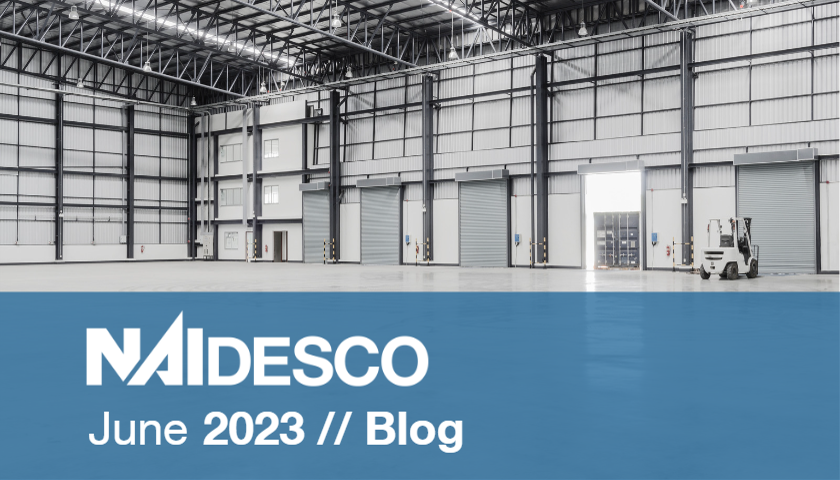NAI Global June 2023 Logistics Journal

June 2023 // NAI DESCO Blog
Trends and Insights on Industrial Real Estate by Experts in Multiple Markets
U.S. Industrial Markets Returns to ‘Normal’ Leasing and Development Activity Yet Don’t
Expect a True Contraction
The recent industrial and logistics virtual meeting hosted by NAI Global and moderated by Steve Pastor with NAI James E. Hanson in Teterboro, New Jersey, covered some of the latest market activity in over a dozen primary U.S. industrial territories and the clearest takeaway from the mid-year meeting is that the mighty industrial market fueled by the pandemic is finally beginning to normalize, meaning there’s one or two prospects for every deal instead of six or seven, and the build-it-and-they-will-come attitudes of developers has turned more cautious.
Foremost, speculative projects over a half-million square feet are increasingly rare. This is hardly to say that demand has fallen off a cliff, because it hasn’t. For example, in Columbus, OH, Matt Osowski, SIOR, reported that Ryder Logistics took 700,000 square feet, paying $5.77 a foot NNN with 3.5% annual increases.
The logistics team then had an active discussion on capitalization rates on industrial assets, and concurred that in tier one markets like New Jersey and California, they remain tight at 4%, whereas Dallas and similar markets with considerable construction activity of new inventory, cap rates are running 4.5% to 5% and in tertiary markets, they are 5.5% to 6%. In general, they are 100 basis points or so higher than a year ago.
There’s more, and here are a handful of recent headlines from some of the leading CRE trade
publications:
- Prologis Expects Industrial Rents Will Increase 10% this Year
- Flooring Retailer Floor & Décor Signs 1.3M SF Industrial Lease at Tradepoint Atlantic (in Baltimore County)
- Chewy Opens Automated Fulfillment Center in Nashville
- Hungry Domestic Market Driving U.S. Southeast Cold Storage Development
- Walmart Beefs Up end-to-end Angus Supply Chain with New Production Facility (in Olathe, Kansas)
The Walmart deal is insightful to how demand for industrial real estate is constantly evolving.
In September last year Walmart disclosed that it was acquiring a minority stake in Sustainable Beef LLC, and just before the acquisition news broke, Walmart debuted a private label beef line called McClaren Farms in stores across the Southeast. In announcing the Olathe facility – which reportedly will cost $257 million to build and create 600 new jobs, Walmart noted that since 2019 the retailer had been working to enhance its beef supply chain and that it concurrently wanted to enter and sell responsibly raised, “steakhouse quality” meats under its own supply chain operations.
In other words, control one’s retail destiny to the degree possible.
In addition to control, efficiency is another keyword that logistics companies are reverential about. To this point, back in April and in newish CEO Andy Jassy’s second annual letter to Amazon’s shareholders, the ecommerce boss said that the company had completed a coast-to coast reorganization of its national fulfillment network into eight ‘interconnected’ regional hubs. One of the goals of the re-org was to shorten travel distances to bring in and process goods, as well as to distribute those products to customers. The other major goal was cost savings. During the pandemic Amazon doubled the size of its logistics network to more than 400 million square feet. Jassy said that since mid-2022 the company has closed or cancelled 99 facilities in its property portfolio associated with logistics.
Meanwhile, for the past couple of years we have been reporting specifics and anecdotally on the increased costs of construction across all commercial real estate asset classes and most notably for industrial real estate. Last month one of the NAI Global industrial specialists sat in on a marketing presentation by one of the leading general contractors of logistics facilities. Part of that presentation zeroed in on construction costs and inflation.
Commodity Inflation in last 30 months
- Steel columns, joists & deck 385%
- Roofing materials (insulation, membrane, fasteners, adhesive) 125%
- Dock equipment & overhead doors (steel & insulation) 100%
- PVC products (HDPE, water pipe, sanitary, conduit, etc.) 90%
- Fire protection 180%
- General inflation across all commodities 10-20%+
- Overall, full construction costs for industrial buildings are up roughly 50% since Jan. 2021, though there has been some price relief beginning in the fall of 2022.
Source: ARCO Construction Co.
ARCO, based in St. Louis, MO, is the largest design/build warehouse/distribution contracting firm in the U.S. and the 34th largest general contractor in the U.S. The firm has built more than 150 million square feet of industrial facilities and has 31 offices and dozens of jobsites nationwide.
Thought Leaders
- Steve Pastor, NAI James E. Hanson, Teterboro, NJ
- Michael Stanzel, SIOR, NAI Robert Lynn, Dallas, TX
- Adam Roth, SIOR, CCIM, NAI Hiffman, Chicago, IL
- Jeff Wilke, SIOR, LEED AP, NAI Latter & Blum, New Orleans, LA
- Bryce Custer, SIOR, CCIM, NAI Spring, Ohio and W. Virginia
- Tyler Culberson, NAI Platform, Albany, NY
- Fred Meyer, SIOR, NAI Mertz, Mt. Laurel, NJ
- Ed Brown, SIOR, CCIM, NAI Tri Properties, Raleigh, NC
- Mike Chambers, NAI Brannen Goddard, Atlanta, GA
- Matt Osowski, SIOR, NAI Ohio Equities, Columbus, OH
- Mike Adams, NAI Summit, Allentown, PA
- Bob Sullivan, NAI Sullivan Group, Oklahoma City, OK
- Clark Everett, NAI Sullivan Group, Oklahoma, City, OK
- Steve Martens, CPM, CCIM, SIOR, NAI Martens, Wichita, KS
- Jim Caronna, SIOR, NAI KLNB, Baltimore, MD
- Jeff Licht, SIOR, NAI Mertz, Philadelphia, PA